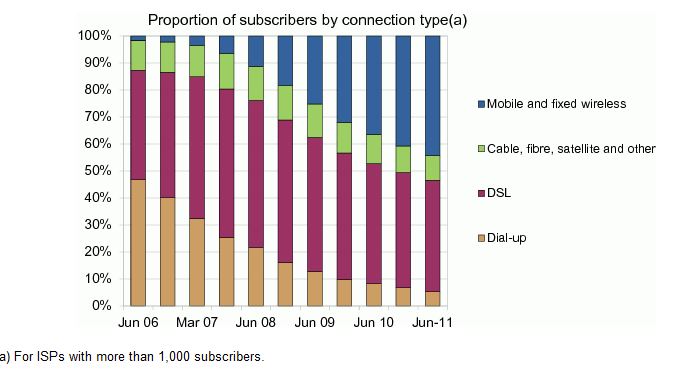Misleading wireless stats harm NBN debate

It was too juicy a morsel for those arguing against the National Broadband Network (NBN) to ignore last week: the latest ABS stats appear to show that wireless is outstripping demand for fixed connections in the home. However, a closer look shows that they do nothing of the kind.
The June 2011 Internet Activity Report from the Australian Bureau of Statistics (ABS) shows that the proportion of broadband connections using wireless devices (tablets, laptops, Kindles etc — but not mobile phones) has exceeded those on a DSL fixed-line connection. But the numbers present a confusing story that actually serves to muddy the broadband debate.
The subsequent misreporting highlights a weakness in the way that the ABS presents its data. Andrew Colley reported in The Australian, for example, that "the number of consumers using some form of wireless service for their broadband, excluding mobile handsets, has surpassed the number using copper line ADSL for the first time".
Whether he's correct or not depends on your definition of consumer. I've always considered a consumer to be distinct from a business customer, and herein lies the problem. The latest figures from the ABS are an aggregate of consumer and business subscribers. They do break down subscribers by type, but we don't know how many are wireless and how many are fixed. More importantly, we don't know how many have both types of connection.
It's important to break out the consumer sector, because business users will be severely skewing the results. In a business, you'd expect growth in wireless devices to far outstrip the number of fixed connections. A business of 20 people might need one or two wireless devices for each staff member, but still only one fixed-line connection.

Subscriber stats (Credit: ABS)
So we really need to see the figures broken down into business and household categories to see what impact mobility is having on fixed-line demand.
But even that is not enough to get a real picture of what's going on. ABS figures for June 2010 show that there are 8.7 million household subscribers. That's impressive penetration, considering that there are only 8.3 million households in the country.
How can this be? Well, the ABS presents its data as if one connection is a substitution for another type. Dial-up, DSL, cable and the like are added to the number of mobile wireless connections to come up with a total for "number of subscribers". That, of course, is not the case. A subscriber could have fixed and wireless access — if you have both, the ABS counts you as two separate subscribers.
Consequently, we're seeing the figures misconstrued. A rise in wireless is being seen as a substitution for fixed broadband by some who look only at the top-line figures, when it's likely that wireless is being used in addition to a fixed connection.
So here's what I reckon the ABS really needs to measure (tell me if you see it differently):
- How many individual households have an internet connection?
(of those, how many fixed-line and wireless connections do they each have?) - How many individual people have direct access to an internet connection?
(of those, how many fixed-line and wireless connections do they have?) - How many businesses have direct access to an internet connection?
(of those, how many fixed-line and wireless connections do they have?)
There would have to be some way of ensuring that wireless connections weren't "double counted" (for example, a business claiming that 100 workers have a wireless laptop, and those 100 individuals are counted independently). Who's to say that there's not an element of that already happening?
This approach would give us a clearer picture of whether any fixed-to-mobile conversion is actually happening. If it is, it would be interesting to know whether this is because of a particular household type (eg, shared, rented, etc) or whether it is down to the available speeds. Has someone chosen wireless because DSL speeds are low, for example.
Otherwise, sorry ABS; the figures are becoming increasingly meaningless and (in the current political climate) they just provide ammunition for the anti-NBN lobby. We should, of course, debate whether the government's approach to broadband is the right thing to do or not, but let's use meaningful statistics to support our arguments.